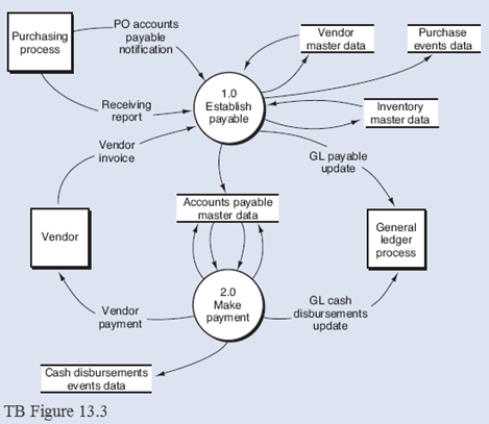Below is a narrative of the "Establish payable" portion (bubble 1.0) of the AP/CD process described in Chapter 13.
Narrative Description
The first step in establishing the payable involves validating the vendor invoice. This process is triggered by receipt of the vendor invoice. Process 1.1 comprises a number of steps. First, the vendor invoice is matched against vendor master data to determine that the invoice is from an authorized vendor. Next, the vendor invoice is compared against the PO data (see the flow PO accounts payable notification) to make sure that there is a PO (i.e., there is an authorized purchase) and that the invoiced items, quantities, and prices conform to the PO. Then, the invoice is matched against the receiving report data to determine that the items and quantities have been received. Finally, the invoice is further validated by checking for accuracy of terms, computed discounts, extensions, and total amount due. Note that the vendor master data is updated at this point to reflect purchase history data.
If the data items do not agree, the invoice is rejected, and follow-up procedures are initiated (see the reject stub emanating from bubble 1.1). If the data items agree, the invoice is approved, and the validated invoice is sent on to the next step to be used to record the payable. Bubble 1.2 depicts the process of recording the payable in the purchase events data and accounts payable master data. A payable is recognized and recorded by:
*Creating a record in the purchase events data stare.
*Creating a record in the accounts payable master data to reflect an apen invaice payment due to a vendar.
*Updating the inventary master data for the cost of the items received.
*Natifying the general ledger of the amount of the payable that was recarded (5ee the data flow "GL payable update"). Required:
From the DFD (TB Figure 13.3) and the narrative description above, explode bubble 1.0 into a lower-level diagram showing the details of that process.

Definitions:
Accounts Receivable
Money owed to a company by its customers for goods or services that have been delivered but not yet paid for.
Merchandise
Goods that are bought and sold in a retail or wholesale environment.
Sales on Account
Transactions where goods or services are sold and payment is deferred, resulting in the creation of accounts receivable for the seller.
Sales on Account
Transactions where goods or services are sold and payment is deferred, leading to the creation of accounts receivable on the balance sheet.
Q3: Which of the following is not a
Q4: Which of the following develops detailed machine-
Q9: The control plan compare vendors for favorable
Q50: Supply chain management software provides available to
Q53: Which of the following involves short production
Q83: An invoice is a business document-either paper
Q93: A representative workload, processed on a vendor's
Q119: When a customer service representative enters data
Q130: Data about vendor compliance with the terms
Q205: The process of evaluating the vendor proposals